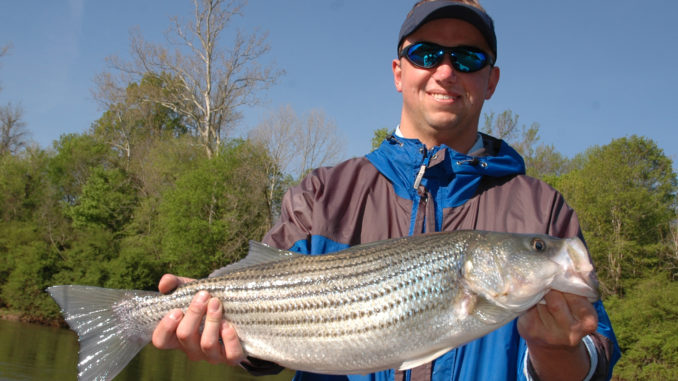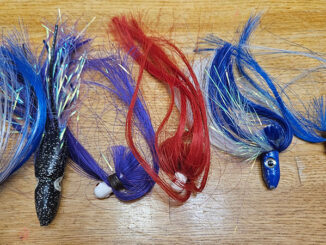
Bass, stripers, even walleye are on same spots
I do a lot of deer hunting in December, and there’s plenty to do around Christmas, but I always make time for a couple of days in the bass boat, because it’s the one month when I can catch several different species of fish, the way I like to fish, without having to run all over the lake.
In the past, I have caught largemouth bass, stripers and even walleye on the same spots, with the same lures, on plenty of trips in December. Plenty of lakes in the Carolinas have both bass and stripers, but only a few also have walleye: Buggs Island and Lake Gaston on the North Carolina-Virginia border, and Lake Hartwell on the South Carolina-Georgia border. I’ve caught a lot of 8- and 9-pound walleye at Buggs Island and Gaston.
A lot depends on exactly how the weather sets up, but on Gaston and Buggs Island, stripers will start moving up in December, getting into range of deep-diving crankbaits, jigging spoons and lipless crankbaits — all in the same places with bass and walleye. I’ve caught them anywhere from 17 or 18 feet deep down to 25 or 26 feet deep.
The walleye are going to always be adjacent to a drop, either into a river channel or creek channel, and the stripers will probably push bait up against a point or a roadbed. They really like structure.
Submerged roadbeds are some of my favorite places to fish in December on Buggs Island and Gaston. Plenty of them are up in the creeks on those lakes, and the fish like to move in there and get shallow on a roadbed, because sometimes the creek channels are too deep. Fish don’t always get up on top of a roadbed, but they will work all around it. It’s like driving up a mountain on a road; not many of them go straight up the side and over, but they wind up and around the mountain. That’s another reason points are so good; fish can come up to a point and move all around it or get up on top of the deep end.
When I set out to try to catch bass, stripers and walleye, I’ve usually got just a handful of lures tied on. One of my favorites is an old 1-ounce Cordell Spot — a big, lipless bait everybody calls a “one knocker.” I like Berkley’s 3/4-ounce Warpig, which is a lipless bait, and Berkley Dredgers in 20.5 and 25.5, plus a 11/2-ounce jigging spoon. I like the heavier spoon because it falls a little faster.
I fish the lipless baits and jigging spoons on Lew’s flipping sticks, 7-foot-6 and 7-foot-11, and I spool my BB-1 reels with 20-pound Trilene monofilament. It’s hard to beat in these situations. I fish the Dredgers on a 9-foot Lew’s David Fritts Perfect Cranking Rod and BB-1 spooled with 10-pound test.
The reason I need the flipping sticks for the lipless baits and jigging spoons is because I don’t vertically jig them. I make long casts and like to hop or drag them back across the bottom. If you’ve got the bait at the end of a long cast in 25 feet of water, you need that long rod to be able to make a good hookset. Without one, you’re not gonna get many of these fish in the boat. The only time I really jig a spoon vertically is if I find a school of walleye on a stump or a brush pile; you can catch them jigging vertically in that situation.
I like to cast my big baits and work them back to the boat. An easy way to fish these baits is to hold the rod at about 11 o’clock and wind the reel six or seven times really fast, then let the bait fall back on a tight line. Most of the time, however, I’ll rip the bait off the bottom and let it fall back while I’m taking up the slack. The bite will feel like a little tick, like a little bream bite. Then, you’ve got to let him have it. When he gets it, if it’s a big striper, you’ve just got to hang on, let him run and wind on him, let him run and wind on him. Make sure you’ve got that reel spooled full of line.
One last note. I always retrieve a bait from shallow to deep; I’ll sit deeper than the spot I’m throwing to. But there are times when I pay more attention to the deeper parts of a piece of structure. I may cast catty-corner across a piece of structure so my bait isn’t in that 10- to 12-foot range as much as it is in that 15- to 18-foot range. That way, you’re in his strike zone longer.
So don’t miss a chance this month to catch some of freshwater’s best fish in some really good places.





Be the first to comment